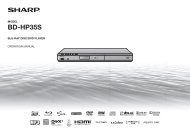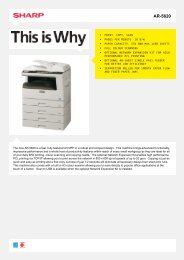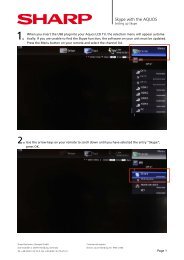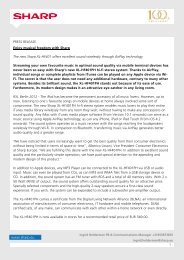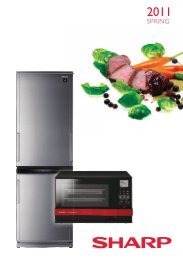R-667-A Operation-Manual GB - Sharp
R-667-A Operation-Manual GB - Sharp
R-667-A Operation-Manual GB - Sharp
Create successful ePaper yourself
Turn your PDF publications into a flip-book with our unique Google optimized e-Paper software.
HEATING<br />
Details for this can be found in the table: Heating food<br />
and drink (see page <strong>GB</strong>-21).<br />
● Ready-prepared meals in aluminium containers<br />
should be removed from the aluminium container<br />
and heated on a plate or in a dish..<br />
● Remove the lids from firmly closed containers.<br />
● Food should be covered with microwave foil, a plate<br />
or cover (obtainable from stores), so that the surface<br />
does not dry out. Drinks need not be covered.<br />
● When boiling liquids such as water, coffee, tea or<br />
milk, place a glass stirrer in the container.<br />
● If possible, stir large quantities from time to time,<br />
to ensure that the temperature is evenly distributed.<br />
● The times are for food at a room temperature<br />
of 20°C. The heating time for food stored in a<br />
refrigerator should be increased slightly.<br />
● After heating allow the food to stand for 1-2<br />
minutes, so that the temperature inside the food can<br />
be evenly distributed (standing time).<br />
● The times given are guidelines which can be varied<br />
according to the initial temperature, weight, water<br />
content, fat content or the result which you wish to<br />
achieve.<br />
DEROSTING<br />
Details for this can be found in the table: Defrosting<br />
(see page <strong>GB</strong>-22). Your microwave is ideal for thawing.<br />
Thawing times are usually considerably shorter than in<br />
traditional methods. Here are a few tips. Take the<br />
frozen item out of its packaging and place on a plate<br />
for thawing.<br />
BOXES AND CONTAINERS<br />
Boxes and containers suitable for microwaves are<br />
particularly good for thawing and heating food, since<br />
they can withstand temperatures in a deep freeze<br />
(down to approx. -40°C) as well as being heat-resistant<br />
(up to approx. 220°C). You can therefore use the same<br />
container to freeze, thaw, heat and even cook the<br />
food, without having to transfer it.<br />
COVERING<br />
Cover thin parts with small strips of aluminium foil<br />
before thawing. Thawed or warm<br />
parts should likewise be covered with<br />
aluminium strips during thawing. This<br />
stops the thin parts becoming too hot<br />
while thicker parts are still frozen.<br />
CORRECT SETTING<br />
It is better to choose a setting which is too low rather<br />
than one which is too high. By so doing you will ensure<br />
that the food thaws evenly. If the microwave setting<br />
is too high, the surface of the food will already have<br />
begun to cook while the inside is still frozen.<br />
TURNING/STIRRING<br />
Almost all foods have to be turned or stirred from time<br />
to time. As early as possible, separate parts which are<br />
stuck together and rearrange them.<br />
SMALL AMOUNTS...<br />
thaw more quickly and evenly than larger ones. We<br />
recommend that you freeze portions<br />
which are as small as possible. By<br />
so doing you will be able to prepare<br />
whole menus quickly and easily.<br />
FOODS REQUIRING CAREFUL HANDLING,<br />
Foods such as gateaux, cream, cheese and bread<br />
should only be partially thawed and then left to thaw<br />
completely at room temperature. By so doing you<br />
will avoid the outer areas becoming too hot while the<br />
inside is still frozen.<br />
STANDING TIME<br />
This is particularly important after thawing food, as<br />
the thawing process continues during this period. In<br />
the thawing table you will find the standing times for<br />
various foods. Thick, dense foods require a longer<br />
standing time than thinner foods or food of a porous<br />
nature. If the food has not thawed sufficiently, you<br />
may continue thawing it in the microwave oven or<br />
lengthen the standing time accordingly. At the end of<br />
the standing time you should process the food as soon<br />
as possible and not re-freeze it.<br />
<strong>GB</strong>-19<br />
R-<strong>667</strong>_[EN ckbk].indd <strong>GB</strong>-19<br />
6/2/09 3:01:59 PM







